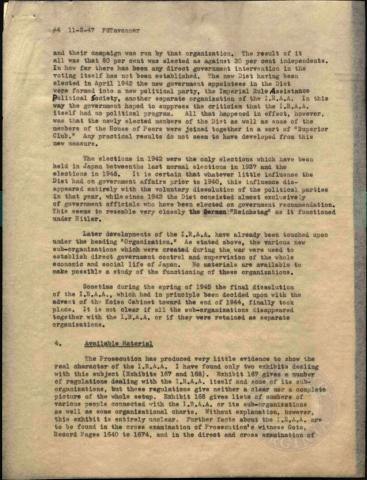
Page 4
| Parent | I.R.A.A. |
|---|---|
| Date | 11 March 1947 |
| Language | English |
| Collection | Tavenner Papers & IMTFE Official Records |
| Box | Box 4 |
| Folder | General Reports and Memoranda from March 1947 |
| Repository | University of Virginia Law Library |
#4 11-3-47 FSTavenner
and their campaign was run by that organization, The result of it all was that 80 per cent was elected as against 20 per cent independents. In how far there has been any direct government intervention in the voting itself has not been established. The new Diet having been elected in April 1942 the new government appointees in the Diet were formed into a new political party, the Imperial Rule Assistance political Society, another separate organization of the 1.R.A.A. In this way the government hoped to suppress the criticism that the l.R.A.A. itself had no political program. All that happened in effect, however, was that the newly elected members of the Diet as well as some of the members of the House of Peers were Joined together in a sort of "Superior Club." Any practical results do not seem to have developed from this new measure.
The elections in 1942 were the only elections which nave been held in Japan between the last normal elections in 1937 and the elections in 1946. It is certain that whatever little influence the Diet had on government affairs prior to 1940, this influence dis¬appeared entirely with the voluntary dissolution of the political parties in that year, while since 1942 the Diet consisted almost exclusively of government officials who have been elected on government recommendation. This seems to resemble very closely the German "Reichstag" as it functioned under Hitler.
Later developments of the I.R.A.A. have already been touched upon under the heading "Organisation." As stated above, the various new sub-organisations which were created during the, war were used to establish direct government control and supervision of the whole economic and social life of Japan. No materials are available to make possible a study of the functioning of these organisations.
Sometime during the spring of 1945 the final dissolution of the I.R.A.A., which had in principle been decided upon with the advent of the Koiso Cabinet toward the end of 1944, finally took place. It is not clear if all the sub-organisations disappeared together with the l.R.A.A. or if they were retained as separate organisations.
4. Available Material
The Prosecution has produced very little evidence to show the real character of the I.R.A.A. I have found only two exhibits dealing with this subject (Exhibits 167 and 168). Exhibit 167 gives a number of regulations dealing with the l.R.A.A. itself and some of its sub- organisations, but these regulations give neither a clear nor a complete picture of the whole setup. Exhibit 168 gives lists of numbers of various people connected with the I.R.A.A. or its sub-organisations as well as some organisational charts. Without explanation, however, this exhibit is entirely unclear. Further facts about the l.R.A.A. are to be found in the cross examination of Prosecution's witness Goto, Record Pages 1640 to 1674, and in the direct and cross examination of
